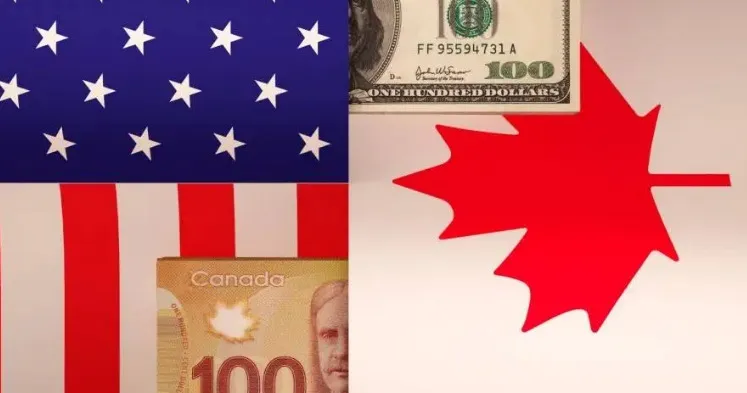Navigating the USD to CAD Exchange Rate: Trends, Insights, and How to Convert Effectively
Introduction
The USD to CAD exchange rate plays a vital role in international trade, travel, investment, and personal finance for both Americans and Canadians. As we move through 2025, this rate continues to fluctuate based on various global and domestic economic conditions.
Whether you're planning to travel to Canada, send money abroad, or simply looking to convert USD to CAD, understanding the factors that drive exchange rate changes can help you make smarter financial decisions. In this blog, we’ll break down what drives the exchange rate, explore current trends, and offer tips for converting your money wisely.
What Does USD to CAD Mean?
The USD to CAD is how many CAD (Canadian dollars) you can get for one dollar (USD) in exchange. This means, for instance, if the exchange rate is 1.35, 1 USD = 1.35 CAD.
This rate is constantly changing based on a wide range of economic and market factors. Even small fluctuations can significantly impact businesses, investors, and travelers.
The USD to CAD exchange rate is determined by several factors
Understanding what moves the exchange rate can help you anticipate changes and time your currency exchanges better.
1. Interest Rate Differentials
Interest rates are adjusted by central banks such as the Federal Reserve (U.S.) and the Bank of Canada to manage inflation and foster growth. Higher interest rates in one country can make its currency more appealing to investors.
2. Economic Performance
A nation’s economy will shape its currency. Analysts interpret things like GDP growth, employment rates, and inflation trends for investors. Good economic news from either country can drive the exchange rate in the country’s favor.
3. Commodity Prices
Canada is a resource-rich nation and heavily relies on exports, particularly oil. When global oil prices rise, the Canadian dollar typically strengthens, since more foreign currency is needed to buy Canadian exports.
4. Trade Balance
When Canada has a trade surplus (when exports exceed imports), it is positive for CAD. A trade deficit could cause the opposite outcome. A major factor is trade with the U.S., its biggest trading partner.
5. Political and Global Events
Elections, economic policies, international conflicts, or sudden market shocks can create volatility in currency markets. Political stability tends to support currency strength, while uncertainty often causes weakness.
2025 Outlook: Key Trends Influencing the USD to CAD Exchange Rate
Economic Recovery
Both the U.S. and Canadian economies are showing growth, though their paths are not identical. This difference in momentum is reflected in the exchange rate fluctuations.
Diverging Interest Rates
The U.S. Federal Reserve has paused rate hikes, while the Bank of Canada is considering further increases. This divergence is making the CAD slightly more attractive in certain scenarios.
Commodity Price Volatility
Oil prices remain unpredictable in 2025, with global supply issues and shifting demand affecting Canada’s currency strength.
Market Sentiment and Inflation
Concerns around inflation and recession fears are making investors cautious. As a result, the exchange rate is seeing short-term swings driven by news cycles and economic updates.
How to Convert USD to CAD Wisely
When you're planning to convert USD to CAD, here are a few steps to help you do it effectively:
Compare Exchange Rates
Check multiple providers, including banks, online currency converters, and specialized forex platforms. Even minor differences in rates can add up.
Watch for Fees
Some services advertise good rates but charge high transaction or service fees. Make sure you check the total cost before converting.
Use Real-Time Tools
Use online tools and currency exchange apps to track real-time rates. Many tools also provide historical data so you can spot trends.
Time Your Conversion
If you’re not in a rush, it may help to wait for favorable market conditions. Monitor news about interest rates, oil prices, and economic data.
Should You Convert Now or Wait?
There’s no guaranteed way to predict future rates, but watching key indicators helps:
- If inflation in the U.S. drops, the USD might gain value, meaning you may get more CAD later.
- If the Bank of Canada raises rates, that could push the CAD up in the short term.
- If oil prices continue rising, the CAD could strengthen, making it a better time to convert USD to CAD now.
Ultimately, the right time to convert depends on your financial goals and timing flexibility.
Conclusion
A combination of economic data, monetary policy, commodity prices, and global sentiment influences the USD to CAD exchange rate. Staying informed about these factors can help you make better decisions when you need to convert USD to CAD.
Whether you're dealing with a one-time currency conversion or you frequently manage cross-border finances, keeping an eye on these trends will save you money and help you plan more efficiently. Use reliable tools, compare your options, and avoid unnecessary fees to get the best value on every transaction.
Website: https://www.interchangefinancial.com/
Address: Toronto Downtown (20 Dundas St. West), Toronto North York, Markham, Brampton
Mobile:- 1 888 972–7799, 1 (416) 227–0963

.jpg)
Comments
Post a Comment